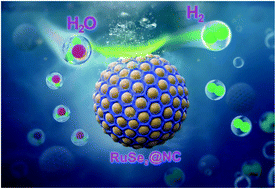Duetting electronic structure modulation of Ru atoms in RuSe2@NC enables more moderate H* adsorption and water dissociation for hydrogen evolution reaction†
Abstract
Electronic structure modulation of catalytic active atoms in catalyst design is an attractive route for realizing active and stable hydrogen evolution reaction (HER). The role of duet or even multiple electronic structure optimization in catalytic intermediate steps of HER remains unexplored in both theoretical and experimental studies. Herein, our theoretical calculations predict that a local N atom with more electronegativity as an additional electron donor can transfer partial electrons to active Ru atom to balance its electron deficiency in RuSe2, where an Se atom as a primary electron modulator takes excess electrons from an Ru atom, enabling more moderate H* adsorption and water dissociation in alkaline HER. We then experimentally demonstrate the positive effect of such duetting electron structure optimization on Ru-catalyzed HER by encapsulating each ∼20 nm RuSe2 nanoparticle within ∼1 nm nitrogen-doped carbon layer (RuSe2@NC) in a one-step molten salt-assisted process. For example, the resultant RuSe2@NC exhibits two-fold enhancement in turnover frequency compared with pristine RuSe2. Impressively, the ultrathin NC layer not only limits the growth of RuSe2 through a spatial confinement effect, but also protects RuSe2 from electrochemical corrosion. Furthermore, RuSe2@NC also shows certain potential in the electrolysis of seawater to produce hydrogen. The duetting electron structure optimization of catalytic active atoms explored through experiments and simulations suggests that the HER performance of catalysts can be further enhanced by balancing electron interactions in multicomponent catalysts.

- This article is part of the themed collection: Journal of Materials Chemistry A HOT Papers


 Please wait while we load your content...
Please wait while we load your content...